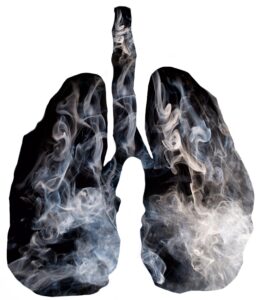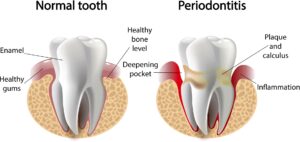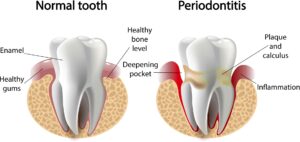Header logo
header top contact widget
Dry Mouth
The Hazards of Vaping Now Include Bone Health
Posted on Jan 12, 2022 by William J. Claiborne, DDS MS
If you’ve switched to vaping (e-cigarettes) as a “safer” alternative to smoking cigarettes, you may have heard that researchers have found this to be a misleading claim, in many regards.
Based on a study published in the American Journal of Preventive Medicine, people who vape have higher risk of developing asthma and chronic obstructive pulmonary disease (COPD). The European Journal of Preventive Cardiology also reports an increased risk of heart problems. Further, the American Lung Association warns that vaping causes a potentially higher cancer risk due to their dangerous mix of chemicals, including acrolein. (Acrolein is toxic to humans when inhaled, resulting in irritation to the upper respiratory tract.)
Now, another health risk has been revealed through research: bone health. In a study of over 5,500 adult users of e-cigs, it was noted that electronic cigarettes may be detrimental to bone health, even in young people. The study, published in the American Journal of Medicine Open, found that people who vape had a 46 percent greater rate of bone fractures.
To make matters worse, the study also found that people who vape in addition to smoking cigarettes have a greater fracture risk than those who are conventional smokers only.
A review in Bone Biology suggests there is negligible difference between vaping and cigarette use when it comes to bone health. It showed that nicotine exposure, regardless of the source, impairs the production of essential cells. Add to that the flavoring chemicals in e-liquids (often known as vaping juice), which are suspected to alter the body’s ability to form new bone.
https://www.thehealthy.com/addition/smoking/does-vaping-affect-your-bone-health/
How this occurs has to do with the inflammatory effects of the nicotine. To retain strength and mass, bones need a sufficient supply of minerals (such as calcium and phosphorus) and nutrients (such as vitamin D). In-depth research published by the European Journal of Clinical Nutrition revealed that smoking interferes with how the bones absorb these essentials. The result is the body’s reduced ability to maintain skeletal strength.
What is frustrating is that vaping hit the market touting itself as a “safer” option than tobacco cigarettes. In 2019, the U.S. Food & Drug Administration took issue with these claims, especially those by the vape pen manufacturer Juul, who marketed its product as a “modified risk” tobacco product, although research did not exist to back its “safer” claim. To the contrary, as research digs deeper and deeper into the risks associated with vaping, data continually stacks up as anything but.
Certainly, there are other contributing factors to compromised bone health. These include:
• Heavy alcohol use
• Being inactive
• A diet low in nutrients like calcium, phosphorus, and vitamin D
• Excessive dieting
Age, menopause, and having a family history of osteoporosis also affect your risk. Too, people with medical conditions (such as hyperthyroidism or anorexia), or taking medications (such as long-term corticosteroids) have a higher risk of bone thinning.
As a dental specialist, the findings associated with bone health are particularly concerning because teeth are enamel-covered bones that protrude above the gum line. Teeth are anchored by bone sections below the gum (tooth roots) and embedded into more bone – the upper or lower jaw bones.
For those who want to quit smoking and have turned to vaping as an aid, the odds aren’t good for successful results. Researchers found that among Americans who’d recently quit smoking, those who were using e-cigarettes were just as likely to relapse in the next year as non-users were.
Findings of one study reported that not only does vaping fail to help former smokers abstain from traditional cigarettes, the risk of relapse was actually slightly higher.
In order to maintain good oral health, it is especially important for smokers and vapers to be committed to a thorough at-home oral care regimen. This includes twice daily brushing, daily flossing and drinking plain water throughout the day. To combat dry mouth, consider using an oral rinse that is specifically formulated to replenish moisture (available OTC).
This should be coupled with having regular dental checkups and cleanings, starting with an examination by a periodontal specialist. A periodontist is a dentist who has received advanced training in the diagnosis and treatment of all stages of gum disease as well as in the placement of dental implants.
Symptoms of gum disease include tender gums that may bleed when brushing, swollen gums that turn red in color, receded gums, and persistent bad breath. As gum disease worsens, pus pockets can form on the gums at the base of teeth and the gum tissues become spongy. Teeth may loosen and may require removal.
Because the initial symptoms of gum disease are not always obvious, a periodontist can determine if gum disease does exist. If it does, he or she can discuss the most conservative treatment necessary to restore your gums to good health and then develop a program to help keep them so.
Our goal is to help each patient achieve a healthy smile for life. For patients who wish to achieve this, we work with each according to individual needs. Through a customized treatment plan, your oral health can be a positive part of your overall health. Call 828-274-9440 for an appointment.
E-Cigs & Oral Health
Posted on Dec 23, 2021 by William J. Claiborne, DDS MS
When it comes to vaping (using e-cigs) health risks to the heart and lungs are what tend to be the focus. However, vaping poses a number of other health risks, one being to your smile.
 Risks to your oral health makes perfect sense. Think about it – the damage from vaping would naturally begin at its entry point: your mouth.
Risks to your oral health makes perfect sense. Think about it – the damage from vaping would naturally begin at its entry point: your mouth.
Although e-cigarettes do not contain tobacco, they are still delivery systems for nicotine. In addition to being addictive, studies show that the inhaled nicotine through vaping can alter the genetic makeup of your cells. This, in turn, stimulates the growth of cancerous cells in the body and increases your risk of developing cancer.
This can lead to tumor growth in the following types of cancer:
• Lung cancer
• Gastrointestinal cancer
• Pancreatic cancer
• Breast cancer
While much remains to be determined about the hazards surrounding this “alternative” delivery system to nicotine, more and more studies are showing unfavorable outcomes. When it comes to oral health, studies are culminating in a mountain of evidence that links e-cigarettes with poor oral health.
A study published earlier this year (iScience) showed that 43 percent of people using e-cigarettes had gum disease and oral infections. That figure jumped to 73 percent among smokers.
Nicotine (inhaled by any means) restricts blood flow to the tissues in the mouth. These tissues are moist by nature and designed to absorb moisture. Because of nicotine’s harmful contents, blood flow is restricted and oral tissues become dryer.
Today’s e-cig user is likely unaware of what’s in the fluid being inhaled. The vaping mist can contain propylene glycol, benzene, formaldehyde and other chemicals.
When the oral tissues repeatedly endure hazardous components, resulting issues can be inflammation, cavities, bone loss of the structures that support teeth, advanced gum disease (known as periodontitis), and oral cancer.
Because vaping is still a recent agent for nicotine, studies on the long-term effects are underway. Still, even without a long history of findings, early studies show concerning results.
When it comes to your oral health, studies indicate that vaping increases the risk of gum disease by causing gum inflammation and swelling. When these issues are combined with a dry mouth and higher levels of bacteria, the likelihood for developing gum disease shoots up significantly.
The common symptoms of gum disease for vapers include:
• Persistent bad breath
• Gums that bleed when brushing teeth
• Tender or swollen gums
• Loose or shifting teeth
• Receding gums
The effects of vaping on the teeth and gums can cause:
Dry mouth – Nicotine from e-cigarettes reduces the saliva in your mouth, your mouth’s rinsing agent. Too little saliva can lead to dry mouth, accumulated plaque (and subsequent development of tartar), increased bacteria, and tooth decay.
Receding gums – Nicotine restricts blood vessels, reducing blood flow to the teeth and gums. Without adequate blood flow, the gums fail to get sufficient oxygen and nutrients. This can cause the gum tissues to decline, which can lead to gum recession. This can result in tooth sensitivity, a higher risk of cavities and even tooth loss.
Bruxism and tooth damage – Nicotine acts as a muscle stimulant, which can lead to tooth grinding (bruxism) or worsen already-existing problems. Grinding or clenching can lead to tooth damage, such as chipped, fractured or broken teeth.
Oral health is a critical element of whole-body health. Two preliminary studies (presented at the American Stroke Association’s International Stroke Conference) linked gum disease with a higher rate of strokes caused by hardening of large arteries in the brain and with severe artery blockages.
A 2018 study in the American Heart Association’s journal Hypertension found that gum disease appears to worsen high blood pressure and interferes with medications to treat hypertension.
It is a misconception to believe that e-cigarettes are healthier than traditional cigarettes, or that vaping isn’t bad for your smile. If you’re a smoker or vaper, be highly committed to having regular dental cleanings and exams as well as your twice-daily oral hygiene routine at home.
If, however, signs of gum disease are already present, have a periodontal examination as soon as possible. Once underway, gum disease will only worsen without treatment. Call 828-274-9440 to schedule or to learn more. As an Asheville periodontist, I have advanced skills in treating all stages of periodontal (gum) disease and in the placement of dental implants.
Our Western NC periodontal dental office also places an emphasis on advanced technology and in comfort options, including oral and IV sedation (twilight sleep).
https://www.heart.org/en/news/2020/08/26/need-another-reason-not-to-vape-your-oral-health-is-at-risk
https://www.deltadentalwa.com/blog/entry/2018/06/ecigarettes-vaping-dental-health
Mouth Sores – What Is Harmless & What To Watch Closely
Posted on Nov 04, 2021 by William J. Claiborne, DDS MS
As the holiday season approaches, our risk for illness goes up. Our chances for picking up colds or the flu increases, which is worrisome on its own. Add that to already-high concerns surrounding exposure to COVID, and we’re all taking added precautions to protect our health.
As in any year, colder months mean we’re more confined to the indoors and in closer proximity to others. With heightened potential for illness, the holidays simply create more stress to our lives. Stress is a contributor to our health as it compromises the immune system. This, in turn, lowers our resistance to fight off illness.
After the holiday mingling constraints endured in 2020, people are trying to take added precautions in 2021 so our “togetherness” is not overshadowed with worries about exposure to illness. To bolster our resistance, many people have had their Covid booster and flu vaccines, practice frequent hand washing, take vitamin supplements such as C, and are trying to stay active physically inside and out-of-doors.
Certainly, we applaud the health safety efforts taken by our Northwest NC population. As an Asheville periodontist, just a added tip for your overall health and well-being: Don’t forget to monitor the inside of your mouth while being committed to the other health measures you’re taking. You may be surprised at what your mouth reveals.
In busy times of year like the holiday season, we see a greater number of individuals who develop canker and cold sores. As stress goes up, your likelihood of getting a cold or canker sore increases as well.
The difference between Canker and Cold sores is:
Canker Sores
These are small ulcers that typically have a white or gray base and red border. Unlike cold sores, canker sores appear inside the mouth and are not contagious. The exact cause of canker sores is uncertain but fatigue, stress or allergies can increase the likelihood of a canker sore. Some experts suspect immune system problems, bacteria or viruses can also spurn eruption. A cut caused by biting the tongue or inside of the cheek as well as hot foods or beverages may contribute to canker sore development. Canker sores usually heal on their own in a week or two. Over-the-counter topical anesthetics, steroid preparations, and antimicrobial mouth rinses can provide temporary relief. As a holistic method, you may try swishing with plain, sugar-free yogurt for a minute or so. This helps to restore a healthy bacteria balance in the mouth while soothing discomfort.
Cold Sores
These are also referred to as fever blisters or Herpes simplex and are located around the lips, under the nose or on the chin. Caused by herpes virus type 1, cold sores are very contagious. These are clusters of fluid-filled blisters that often erupt since are they are most commonly found around the edge of the lips. Cold sores are Herpes lesions that may follow a fever, sunburn, skin abrasions or emotional upset. Because cold sore blisters are on the outside of the mouth, they can be embarrassing and uncomfortable. Although they usually heal in a week, over-the-counter topical anesthetics may speed the process while providing some relief. In our office, we can use a dental laser to hasten healing, often within a couple of days. If occurrences are frequent, ask about prescription drugs that can help reduce the duration of these viral infections.
Other issues your mouth’s interior can reveal include:
White Coating On Tongue
The tiny, bumpy protrusions on the tongue’s surface are papillae. Papillae are our source for taste and touch, allowing for feeling food’s form and texture. Saliva and food residue can become embedded in the grooves between the papillae, especially on the back portion of the tongue. This can create areas for rapid bacterial growth. As bacteria accumulate, a whitish film coats the tongue, which leads to bad breath. Let your white tongue be a warning sign of too much bacteria and take measures to manage it before cavities and gum disease develop. It’s important to keep the mouth moist since a dry mouth provides a breeding ground for bacteria reproduction. Drying sources, in addition to age, include smoking, alcohol consumption, caffeinated foods and beverages, and many prescription and OTC medications. Uproot bacteria in the tongue daily by brushing the tongue with your toothbrush after brushing teeth. Some toothbrushes have a tongue scraper on the back side of the bristles or you may want to purchase a tongue scraper. These are flexible strips you use to scrape over the tongue’s surface in a back to front motion.
Cheek Biting
Cheek biting can occur from a minor accident, such as during a fall. It can also occur from careless chewing or talking while eating. Cheek bites can occur more frequently due to a bite that is misaligned. A disparity in the bite can disrupt the harmonious congruency of upper and lower teeth while chewing and speaking. Cheek biting can be a symptom of bite misalignment. Other signs may indicate temporomandibular joint (or TMJ) disorders, which often result from a misaligned bite. Thus, cheek biting can be related. Too, TMJ disorders can cause night-time clenching or grinding of teeth. During these actions, you may be unknowingly biting the inside of your cheek while asleep. Cheek biting can cause inflammation at the location of the bite and can also result in canker sores. Chronic cheek biting can result in redness, painful sores, and tears in the mouth’s inner lining. Repeated bites can cause the oral tissues to become thick, scarred, and paler in the affected area. This surface can prompt the individual to continue biting in an attempt to create a smooth surface. If cheek biting has become habitual, there may be an emotional cause, such as stress, anxiety, depression, or even genetics. This should be discussed with your primary care physician.
Oral Cancer
It is important to pay close attention to any change to oral tissue that does not heal within 10-14 days. When oral tissue does not repair on its own in a week or so, it should be examined by your dentist or periodontist without delay. Some of these spots can be a symptom of oral cancer.
Oral cancer has one of the worst survival rates of all cancers. Because symptoms can mimic a bite on the inside of your cheek, more obvious symptoms often do not emerge until the cancer has reached advanced stages. Of those who acquire oral cancer, only 57% are estimated to still be alive 5 years later. Know the signs of oral cancer, which include:
• white or red patch of tissue
• unusual lesion in the mouth
• difficulty or discomfort when swallowing
• persistent sore throat or feeling something is stuck in the throat
• a lump or mass inside the mouth or neck
• wart-like mass
• numbness in the mouth or face
Lesions or discolorations that are early warning signs are not always visible, particularly in the back portion of the mouth. Because symptoms emerge slowly, the delay in early diagnosis and treatment can have deadly consequences. This reinforces the need to maintain regular oral hygiene exams and cleanings every six months. During these times, unusual changes in the mouth can be noted and, if concerning, further steps can be taken. Remember, never wait until your next dental check-up appointment to have anything unusual examined.
 Bleeding Gums
Bleeding Gums
Contrary to what some people believe, having gums bleed at any time is not normal. Seeing blood in the sink when you brush is not a sign you’re doing a good job. It’s a sign that the gum tissues are either being scrubbed too harshly or the gum tissues are infected by accumulated oral bacteria. If you notice bleeding – at all – take extra measures to maintain excellent oral hygiene at home. This includes twice daily brushing, daily flossing, using an oral rinse, keeping the mouth moist (ideally by drinking plain water), and limiting sugar. If bleeding continues for more than a couple of days, make a dental appointment. You may have developed Gingivitis, which is an early stage of gum disease. Halting this in its tracks early can save you greatly in treatment time and expenses.
The interior of your mouth can be a great indicator of your health in other areas. Just be sure to look inside and stay proactive on steps needed to keep the interior “in the pink”. Again, if an unusual spot or sore is still present after two weeks, call 828-274-9440 immediately for an appointment.
Misconceptions Of Oral Health
Posted on Sep 14, 2021 by William J. Claiborne, DDS MS
As a periodontal dental specialist, I have advanced skills in the treatment of gum disease and dental implants. In my specialty, I see patients who have various issues related to oral health. Some of these can be resolved with minor treatment and others require more involved procedures.
In many cases, however, a factor in the severity of certain issues occur because it was assumed the problem would resolve itself. Some patients have also assumed that certain signs or symptoms were “normal”.
The health of the mouth is largely reliant on the condition of the gum tissues. This moist, soft covering of tissues is a protective blanket for the structures underneath. Gum tissues protect the structures that support natural teeth as well as their roots.
Yet, because the gums are not visible as are teeth, it is easy to “back burner” problems. Some of these problems DO resolve on their own. However, in too many cases, what is set aside eventually requires extensive treatment; treatment that may have easily been avoided with early care.
I’d like to address some of the more common issues I see that are misconceptions…
Assuming seeing blood in the sink when brushing teeth is normal: Srubbing teeth so rigorously that they bleed is not a sign of doing a good job. This action not only wears away precious tooth enamel, it wears away the gum tissues that wrap the base of teeth.
Gums that bleed when brushing are also a symptom of periodontal (gum) disease. In addition, gum disease can cause tenderness, swelling or frequent bad breath. Without treatment, gum disease will progress further. This is why it is the nation’s leading cause of adult tooth loss.
Protect tooth enamel and gum tissues by using a soft to medium bristled toothbrush and a non-abrasive toothpaste (never substances such as baking soda). Using a swirling motion (rather than going back-&-forth), avoid applying too much pressure. Make sure that the tips of the bristles are contacting the surfaces of teeth. Hint: If you notice your toothbrush’s bristles flay outward after a month or so of use, you’re pressing too hard.
Ignoring gum recession: The gums are designed to snugly wrap the base of each tooth, serving to seal out bacteria. Although the aging process and oral dryness can shrink gum tissues, a common cause of receded gums is gum disease.
Gum recession is what causes sensitivity to hot, cold or the bristles of a toothbrush. Oftentimes, a bite of ice cream can send a jolt of pain. Even without the sensitivity, recession can leave the darker tooth root areas exposed. This leaves the tooth vulnerable to damage by oral bacteria.
Ignoring frequent bad breath: Bad breath is typically a by-product of bacteria build up. Although certain medical conditions can contribute to bad breath, keeping oral bacteria levels under control will minimize the risk of having smelly breath odor.
Saliva is what controls a significant amount of oral bacteria. However, without regular brushing and flossing, bacteria can quickly exceed what saliva is able to manage.
This is why it is important to brush twice daily and floss daily. These small tasks help to control bacteria by removing the sticky buildup of plaque. If not removed, plaque hardens into what is known as tartar. Tartar is a destructive mass of bacteria that can no longer be brushed or flossed away.
Having gum depth measurements of four and over: During regular check-ups, hygienists check gum health by gently using a probe along the base of each tooth. This is done to indicate loosening of gum tissues on the front and back sides of teeth. A good check-up will have no depth measurement higher than a three.
If the depth measures a 4 or 5 (or higher), the gums are not sealing out oral bacteria sufficiently. This may be an indication of gum disease. The higher the number, the more advanced it is.
Assuming tooth loss is normal: Some people assume tooth loss is a natural part of the aging process. This is not accurate. Adults lose teeth due to accidents, decay or (most often) gum disease.
Occasionally, a tooth that needs crowning or filling is deemed a “problem” tooth. This causes some people to want the tooth removed rather than repaired. Yet, missing tooth roots in the jaw bone triggers a process of bone shrinkage. This is known as resorption.
Resorption occurs without the stimulating presence of the tooth root. As the bone declines in height and width, neighboring teeth can also be affected. Adjacent tooth roots in areas of insufficient bone structure are at a higher risk of cavities, gum disease, and tooth breaks or fractures. Statistics show that a tooth adjacent to a missing tooth is most likely the next to be lost.
When a tooth must be removed, we recommend replacing it with a dental implant. Because an implant is positioned in the bone, it helps halt bone loss and protect the well-being of neighboring teeth.
Not reacting to spots on the tongue, lips or inside the cheek: People occasionally develop canker sores inside the mouth. These can be caused by stress or having an acidic diet. Both should go away within ten days or so.
Any spot or change inside the mouth or throat that does not resolve on its own within two weeks should be seen immediately. This may be a sign of oral cancer and may appear as a red or white spot. Or, it may cause hoarseness or difficulty swallowing. If caught early, oral cancer can be successfully treated. Acting promptly is highly important as it can lead to disfiguring treatment and be even deadly.
Assuming oral health is contained in the mouth: It has been shown that having good oral health is an advantage to having good overall health. The potent bacteria of gum disease can enter the bloodstream and cause inflammatory reactions elsewhere in the body. Research has correlated a number of serious health problems with the infectious bacteria of gum disease. These include heart disease, stroke, some cancers, Alzheimer’s disease and arthritis.
As an Asheville periodontist, I believe that adults can improve their oral health by being informed patients and committed to having a healthy smile.
A good resource on maintaining good oral health is the web site of the American Academy of Periodontology: www.perio.org (go to Patient Resources). Or, call our Asheville periodontal dental office at 828-274-9440.
Recent Posts
Categories
Archives
- September 2024
- August 2024
- July 2024
- June 2024
- May 2024
- April 2024
- March 2024
- February 2024
- January 2024
- December 2023
- November 2023
- October 2023
- September 2023
- August 2023
- July 2023
- June 2023
- May 2023
- April 2023
- March 2023
- February 2023
- January 2023
- December 2022
- November 2022
- October 2022
- September 2022
- August 2022
- July 2022
- June 2022
- May 2022
- April 2022
- March 2022
- February 2022
- January 2022
- December 2021
- November 2021
- October 2021
- September 2021
- August 2021
- July 2021
- June 2021
- May 2021
- April 2021
- March 2021
- February 2021
- January 2021
- December 2020
- November 2020
- October 2020
- September 2020
- August 2020
- July 2020
- June 2020
- May 2020
- April 2020
- March 2020
- February 2020
- January 2020
- December 2019
- November 2019
- October 2019
- September 2019
- August 2019
- July 2019
- June 2019
- May 2019
- April 2019
- March 2019
- February 2019
- January 2019
- December 2018
- November 2018
- October 2018
- September 2018
- August 2018
- July 2018
- June 2018
- May 2018
- April 2018
- March 2018
- February 2018
- January 2018
- December 2017
- November 2017
- October 2017
- September 2017
- August 2017
- July 2017
- June 2017
- May 2017
- April 2017
- March 2017
- February 2017
- January 2017
- December 2016
- November 2016
- October 2016
- September 2016
- August 2016
- July 2016
- June 2016
- May 2016
- April 2016
- March 2016
- February 2016
- January 2016
- December 2015
- November 2015
- October 2015
- September 2015
- August 2015
- July 2015
- June 2015
- May 2015
- April 2015
- March 2015
- February 2015
- January 2015
- December 2014
- November 2014
- October 2014
- September 2014
- August 2014
- July 2014
- June 2014
- May 2014
- April 2014
- March 2014
- February 2014
- January 2014
- December 2013
- November 2013
- October 2013
- September 2013
- August 2013
- July 2013
- June 2013
- May 2013
- April 2013
- March 2013
- February 2013
- January 2013
- December 2012
- November 2012
- October 2012
- September 2012
- August 2012
- July 2012
- June 2012


